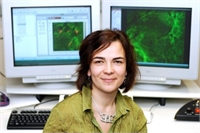Seminars
Thu |
Nonlinear Optical Imaging To Assess Metabolism In The Good, The Bad And The Ugly (a.k.a. Stem, Cancer And Fat Cells) | |
Co-sponsored by the IEEE Signal Processing Society | ||
|
Abstract: Changes in cellular metabolism play a key role in the normal or diseased development of cells and can serve as important diagnostic biomarkers in a number of areas ranging from cancer to diabetes to regenerative medicine. Traditional assays for metabolic characterization are invasive and can introduce artifacts. In this presentation, I will discuss the use of natural cellular two-photon excited fluorescence as a method to acquire metabolic information in a sensitive and quantitative way, obviating the need to process the sample in any way and offering great potential for clinical translation. I will demonstrate how high-resolution images of three-dimensional tissue specimens can be analyzed to reveal subtle metabolic changes that occur during stem cell differentiation and upon the onset of cancer.
Recommended Reading: Quantitative metabolic imaging using endogenous fluorescence to detect stem cell differentiation.http://www.ncbi.nlm.nih.gov/pubmed/24305550
Quinn KP, Sridharan GV, Hayden RS, Kaplan DL, Lee K, Georgakoudi I., Sci Rep. 2013.
Biography: Irene Georgakoudi studied physics at Dartmouth College, and received her PhD in Biophysics at the University of Rochester. Following postdoctoral work at the MIT Spectroscopy Laboratory and the Wellman Laboratories for Photomedicine at Massachusetts General Hospital, she joined the Department of Biomedical Engineering at Tufts University, where she is currently an Associate professor.
Her work focuses on the development of linear and non-linear spectroscopic imaging approaches that rely on endogenous sources of optical contrast to characterize tissues. She is particularly interested in the use of these techniques for early cancer detection and monitoring of engineered tissue development. She has co-authored nearly 100 peer-reviewed articles and book chapters, has served to organize a number of conferences and as member of the OSA Board of Directors. She is an Associate Editor for PLoSONE. She is the recipient of a Claflin Distinguished Scholar award, an NSF Career award, and an American Cancer Society Research Scholar award. Location: MIT Lincoln Laboratory |

